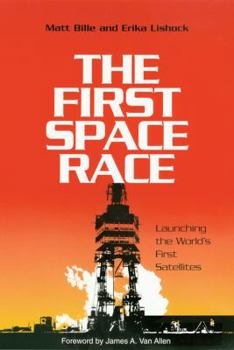The First Space Race: Launching the World's First Satellites
(Part of the Centennial of Flight Series Series)
Select Format
Select Condition 
Book Overview
The First Space Race reveals the inside story of an epic adventure with world-altering stakes. From 1955 to 1958, American and Soviet engineers battled to capture the world's imagination by successfully launching the world's first satellite. The race to orbit featured two American teams led by rival services--the Army and the Navy--and a Soviet effort so secret that few even knew it existed. This race ushered in the Space Age with a saga of science, politics, technology, engineering, and human dreams. Before 1955, the concept of an artificial satellite had been demonstrated only on paper. The first nation to transform theory into practice would gain advantages in science, the Cold War propaganda contest, and the military balance of power. Visionaries such as America's Wernher von Braun and Russia's Sergey Korolev knew these fields of endeavor would be affected by the launch of a satellite. Moved by patriotism, inquisitiveness, and pride, people on both sides of the Iron Curtain put forth heroic efforts to make that first satellite possible. Some aspects of this story, like the Navy's NOTSNIK satellite project, are almost unknown. Even some details of well-known programs, such as the appearance of America's pioneering Explorer 1 satellite and the contributions made by its rival, Project Vanguard, are generally misremembered. In this book, authors Matt Bille and Erika Lishock tell the whole story of the first space race. They trace the tale from the origins of spaceflight theory and through the military and political events that engendered the all-out efforts needed to turn dreams into reality and thus shape the modern world.
Format:Paperback
Language:English
ISBN:1585443743
ISBN13:9781585443741
Release Date:August 2004
Publisher:Texas A&M University Press
Length:232 Pages
Weight:0.80 lbs.
Dimensions:0.7" x 5.1" x 9.1"
Customer Reviews
1 rating
What was the World Like Before Spaceflight?
Published by Thriftbooks.com User , 20 years ago
The authors have written a fine historical synthesis of the period between the mid-1950s and the aftermath of Sputnik, focusing on the rivalry between the United States and the Soviet Union to launch the first orbital satellite. This work makes an important contribution in focusing on this first satellite race, and the authors explore the mirror image nature of the two programs, how they played off of each other, and why that was necessary to the manner in which the race unfolded. By keeping the space race front and center they succeed in creating a focus that is compelling and often missed in other studies of the same era. Bille and Lishock are at their best in probing the individuals who were the bearers of the spaceflight dream; many of whom seem to encounter obstacles (social, political, technical) at every turn, and then eventually surmount them to achieve success and plant the seeds for future accomplishment. At some level this represents a romantic narrative of transcendence, but one that is both evocative and powerful. The authors seem to suggest that it was the spaceflight true believers, rather than great nations locked in cold war rivalry or geopolitical machinations or the scientific method on each side, who were engaged in a race. Certainly they expressed frustration by the percerived foot dragging of their respective governments. Yet, Sergei Korolev in the Soviet Union and Wernher von Braun and others in the United States achieved the birth of the space age in this international race. Everyone should realize, of course, that this work is a synthesis. It is not intended as a sophisticated theoretical work--although something taking a post-modern approach to the subject would be quite interesting. It is, instead, a narrative that seeks to create a unified discussion of the rise of the American and Soviet rocket states. That rise, as the authors show, had long antecedents going back to the very earliest years of the twentieth century in both nations and a sophisticated technological base that allowed that longstanding vision to become reality. The authors also do a credible job of explaining the development of the Soviet Sputnik and the American Vanguard and Explorer programs. These represented the major elements of the "first space race" suggested in the title. While there is little new in this discussion the authors do a good job of bringing together salient elements from a wealth of serious historical writing on the subject in the last decade. This represents the best narrative available synthesizing this story.






